How to Generate Music with AI (A Practical Guide)
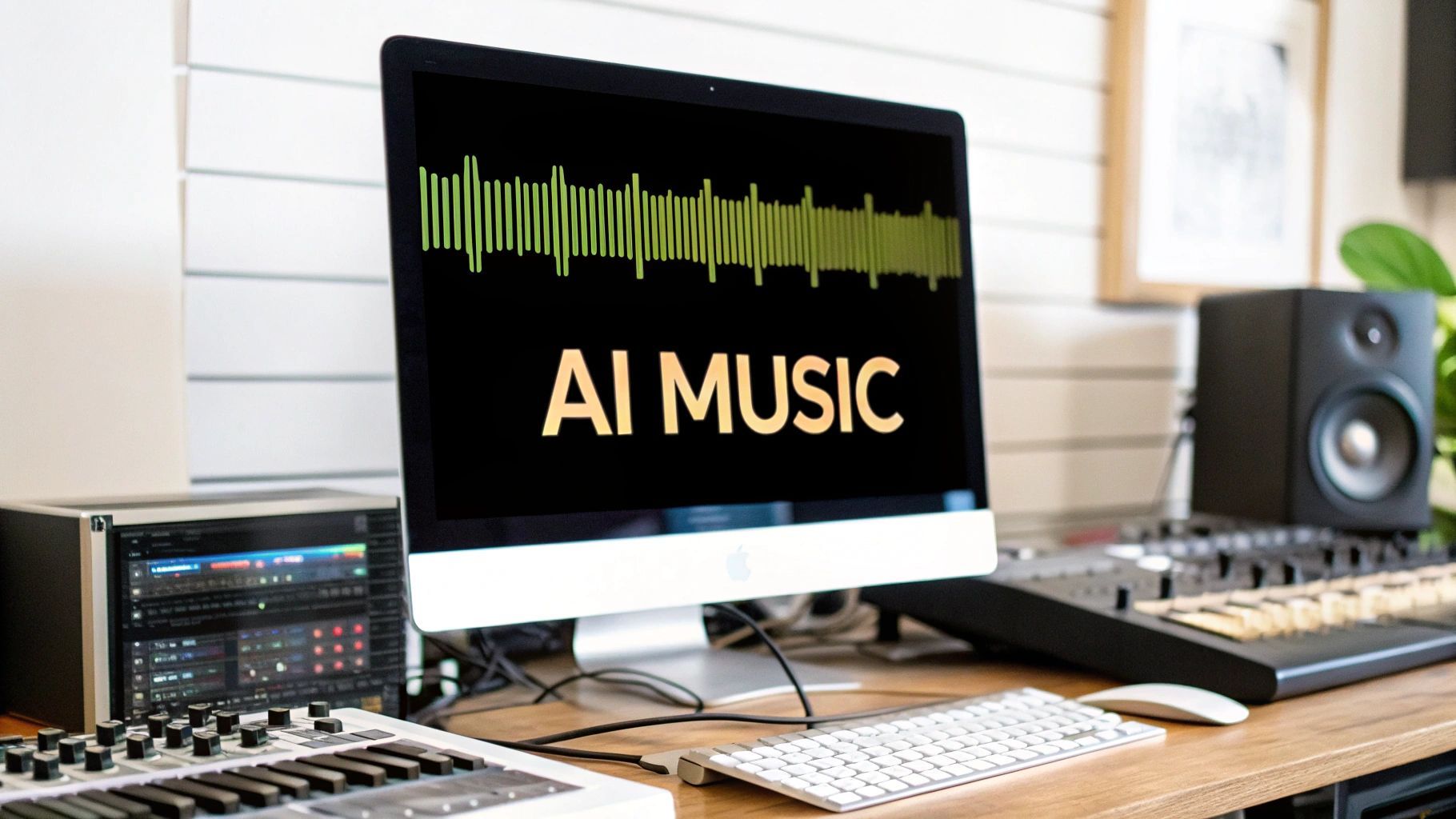


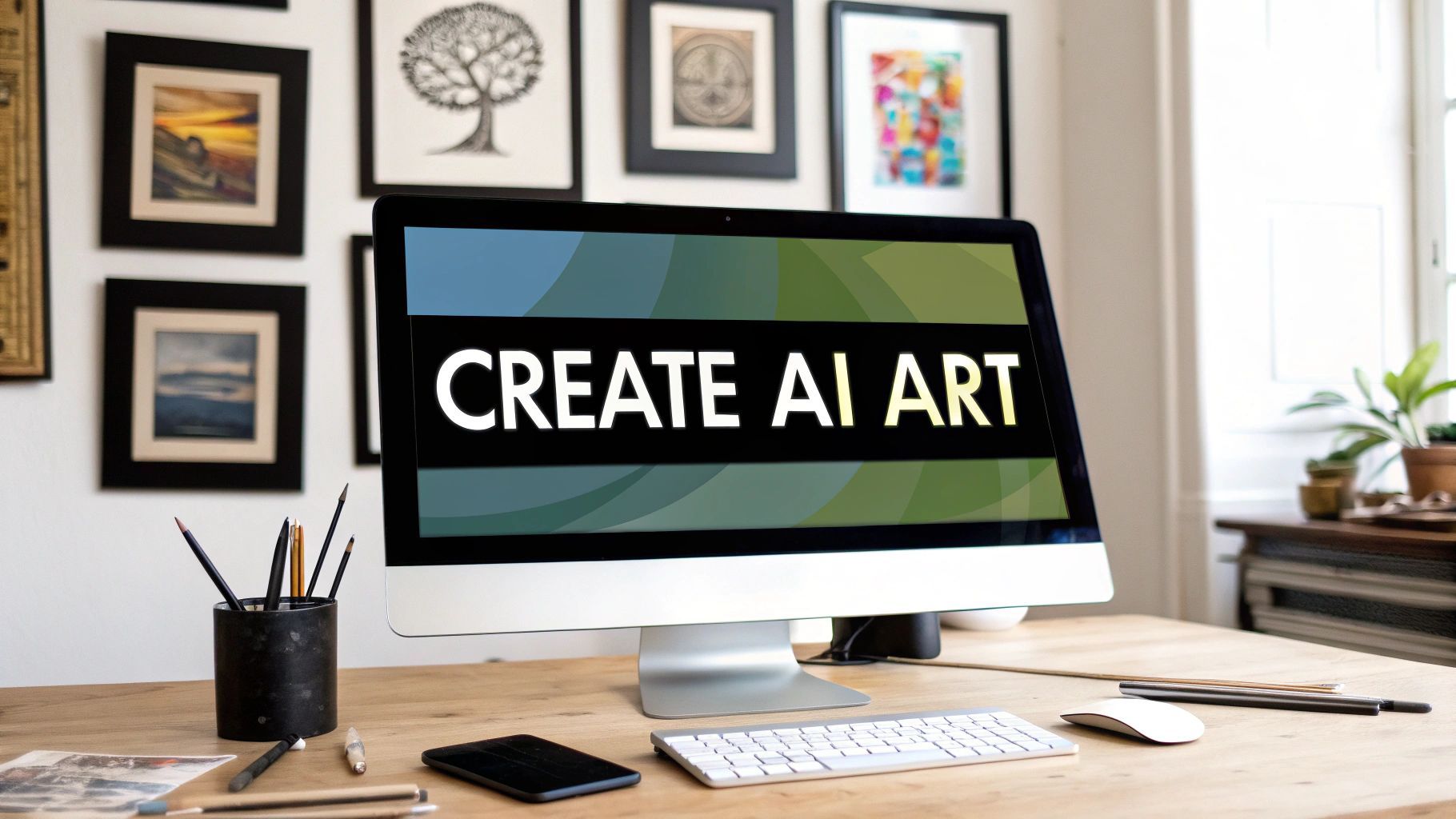
Ready to learn how to create AI art? This guide breaks down the best tools, prompt writing secrets, and refinement techniques to make your ideas reality.
So, you want to make some magic with AI art? You're in the right place. At its heart, creating AI art is all about a conversation between you and an algorithm. You paint a picture with words, and the AI brings it to life. The real secret isn't some complex technical skill; it's about learning to communicate your creative vision.
Ever scrolled past an image online and just thought, "Wow. How did they do that?" Chances are, you’ve just had a run-in with the wild and wonderful world of AI art. And guess what? You can do it, too. This isn't about being a coding wizard or a tech guru. It's about finding a creative partner in a powerful new tool.
Forget the dry, intimidating guides. Think of this as your personal tour, designed to take you from "What's a prompt?" to "Check out what I just made!"
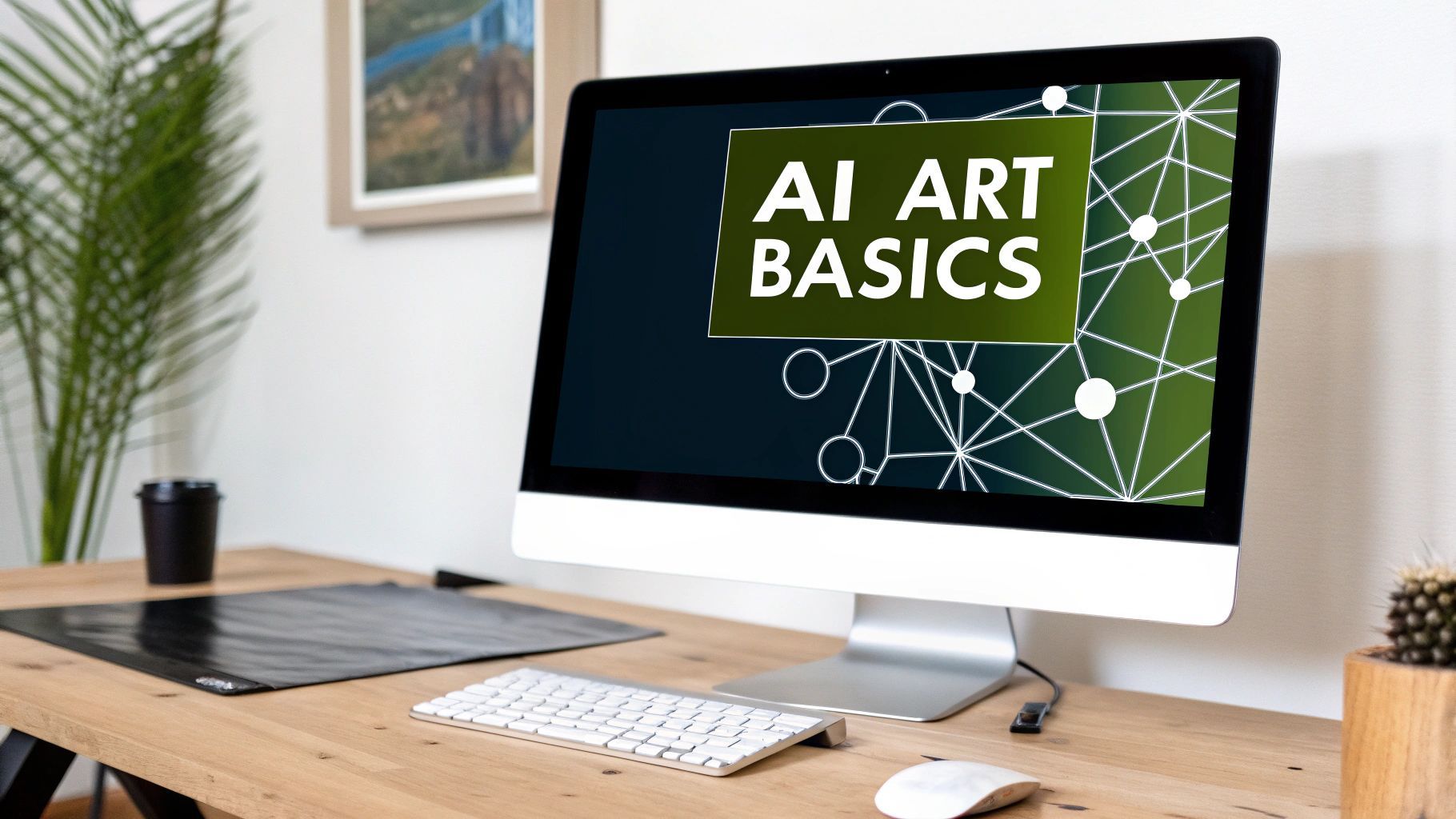
A clean, simple interface—like the one you'll find on platforms like SendFame—is your best friend. It lets you jump straight into the fun part: creating. No need to get bogged down in a million confusing settings.
We're going to walk through choosing the right tools, learning to "speak AI" with killer prompts, and tweaking your creations until they're perfect. This is your art class for the 21st century, and the only limit is your imagination.
This isn't just some passing trend for a few tech-savvy artists. We're witnessing a full-blown creative explosion. The AI art market was already valued at a cool $298.3 million in 2023. Fast forward, and it's projected to rocket towards $8.6 billion by 2033.
What does that tell you? It means you're jumping into a booming, vibrant field at the perfect moment. The tools are getting smarter and easier to use every single day, and you’re not just picking up a new hobby—you’re joining a global creative movement.
Here’s the really exciting part. The skills you're about to learn—crafting detailed, evocative prompts—are your ticket to so much more than just static pictures. These generative AI technologies are a creative Swiss Army knife.
The Big Idea: Mastering the art of the prompt is the key that unlocks the door. It's the core skill for creating everything from a simple portrait to a complex animation.
Once you get the hang of describing a scene, a style, and a mood for an image, you'll realize it's the exact same logic you'd use to storyboard a film. If that gets your creative gears turning, you should check out our guide on how to create an AI music video, which builds on these very same ideas.
Your journey might start with a single image, but it can lead to creating entire cinematic worlds.
Alright, let's talk about picking your creative weapon. Diving into AI art generators can feel like walking into a wizard's shop—so many wands, so many spells. You've got the super-technical ones like Midjourney that operate through a Discord server, and then you have more straightforward tools like DALL-E 3. It’s easy to get overwhelmed.
The secret? For your first foray, find a tool that gets out of your way and lets you create. You need something that’s intuitive, flexible, and doesn't require a degree in computer science to get started.
This is exactly why I often point newcomers toward platforms like SendFame. Its entire design is about letting you focus purely on your ideas, not on wrestling with complicated settings. You can jump right in and start making cool stuff, which makes it a perfect launchpad.
This chart gives you a bird's-eye view of who's who in the AI art world.
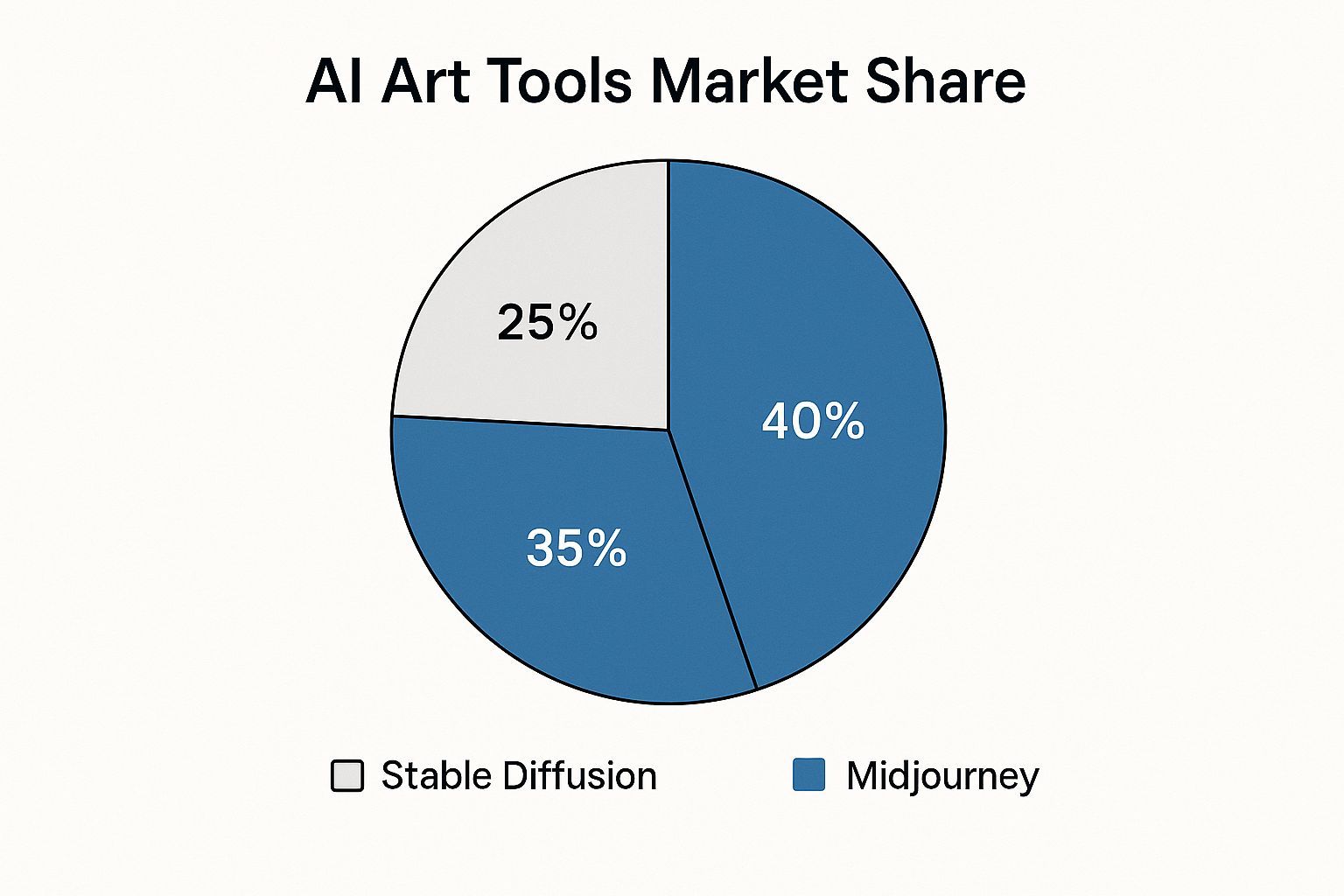
As you can see, a few big names dominate the scene. But don't just follow the crowd! The most popular tool isn't always the best one for you. It’s all about finding the perfect match for your creative flow.
When you're just starting, it's easy to get bogged down by a million different features. Forget all that noise. Just focus on a few things that actually matter for a beginner.
Here’s my personal checklist for picking a winner:
A No-Headache Interface: Can you figure it out in five minutes? You should be spending your time making art, not deciphering a user manual. This is where tools built for simplicity, like SendFame, really win. Plays Well With All Styles: You need a tool that can be a chameleon. Can it whip up a photorealistic portrait one minute and a trippy, abstract piece the next? A wide stylistic range gives you the freedom to experiment and find your voice. Good Vibes and Support: Is there an active community? Being able to see what other people are creating—and ask for help when you get stuck—is a massive advantage. It's how you learn the tricks of the trade.
The growth in this field is just staggering. The AI art market was valued at around $3.2 billion in 2024, and it's projected to rocket to nearly $40.4 billion by 2033. That boom tells you these tools are quickly becoming a core part of the modern artist's toolkit.
To help you get a clearer picture, I've put together a quick comparison of some of the top contenders. Think of this as a cheat sheet to find the platform that best fits your vibe right now.
| Tool Name | Best For | Ease of Use | Typical Cost |
|---|---|---|---|
| SendFame | Beginners and all-in-one content creation | Excellent | Subscription model with various tiers |
| Midjourney | Highly stylized, artistic, and cinematic images | Moderate | Subscription-based |
| DALL-E 3 | Integration with ChatGPT and direct text-to-image | Good | Included with ChatGPT Plus subscription |
| Stable Diffusion | Total customization and open-source tinkering | Difficult | Free (but requires powerful hardware) |
Each of these platforms has its own personality and strengths. Starting with a more approachable tool lets you master the fundamentals of prompting and image creation before you dive into the deep end.
For a much more detailed look, you should absolutely check out our guide on the best AI art generator, where we break down even more options based on different creative goals.
Let's get one thing straight: the magic of AI art isn't buried in complicated settings or hidden menus. It's all about communication. The real skill is learning how to talk to the AI. Think of yourself as an art director, and the AI is your incredibly talented, but very literal, assistant.
The better you can describe the masterpiece in your head, the closer the AI will get to creating it. We're moving way beyond simple commands like "a cat." We're going to build a visual language that translates your imagination into a set of instructions the AI can't misinterpret. This is where the fun really begins.
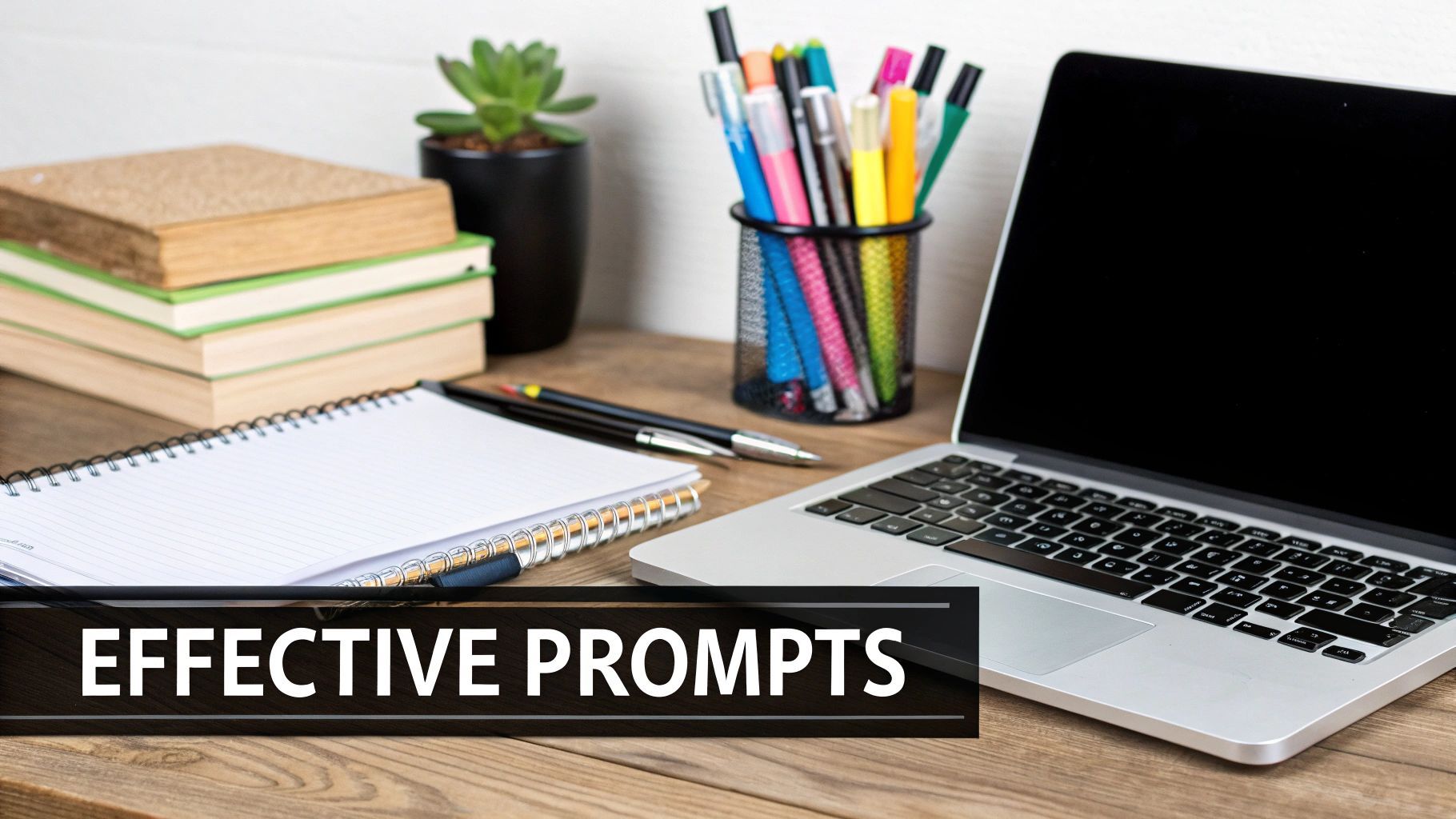
A great prompt is basically a recipe. If you just ask for "cake," you’ll get a cake—probably a bland, generic one. But if you ask for a "three-layer dark chocolate fudge cake with raspberry filling and vanilla buttercream frosting," now you're talking. You're going to get something much, much closer to what you were dreaming of.
So, what are the key ingredients for an AI art recipe? It boils down to a few core components that take an idea from vague to vivid.
Subject: The "what." Be specific! Don't just say "dog." Try "a goofy golden retriever puppy, mid-pounce, with floppy ears." See the difference? Style: This is your artistic lens. Is this "hyperrealistic photography," a "Van Gogh-style oil painting," "vintage anime," or "Art Deco poster art"? The style sets the entire vibe. Lighting: This is a game-changer for mood. Is your scene lit by a "soft morning glow," "dramatic, high-contrast studio lighting," or maybe it's "drenched in neon city lights"? Composition: Tell the AI how to frame the shot. Are we looking at a "tight close-up portrait," a "sprawling wide-angle landscape," or a funky "Dutch angle" shot to create a sense of unease? Mood: How should the final image feel? Words like "serene," "chaotic," "nostalgic," or "menacing" inject pure emotion into the art.
Nailing these elements is what separates a lucky guess from a masterpiece you created on purpose.
My go-to prompt recipe usually follows this structure: [Composition] of a [super-detailed subject], [artistic style], [lighting description], [mood/atmosphere]. It's a solid formula that gives the AI a clear roadmap to follow for almost any idea I throw at it.
Let’s watch this unfold. We'll start with a painfully simple prompt and build on it, layer by layer, to see how each new detail pushes the AI closer to a truly awesome result.
The Bare-Bones Prompt: a castle
You'll get a castle, alright. But it'll be the most generic, boring castle imaginable. The AI is just guessing because you gave it nothing to work with.
Adding Some Flavor: a medieval fantasy castle on a mountaintop, digital art
Okay, now we're getting somewhere. We’ve given it a genre, a location, and a medium. The results will immediately be more focused and less like a random clipart image.
Injecting Drama and Story: a medieval fantasy castle on a mountaintop, digital art, stormy sky with lightning, dramatic lighting, epic
Boom. Suddenly, our image has a story. It has a mood. The stormy sky and dramatic light create a feeling of tension and grandeur. We’ve gone from a picture of a thing to a scene that evokes an emotional response. This process of adding and refining is the core of creating great AI art.
Sometimes, telling the AI what you don't want is just as important as telling it what you do. This is where negative prompts are your best friend. Think of them as guardrails that keep the AI from veering off into weird territory.
For example, AI models are notoriously bad at hands. You've probably seen the nightmare fuel—portraits with people who have six fingers or twisted claws. A negative prompt is the perfect fix.
Your Prompt: a beautiful portrait of a queen Negative Prompt: extra fingers, poorly drawn hands, disfigured, ugly
By adding that simple instruction, you're telling the AI to actively avoid those common flaws. It’s a simple trick that dramatically cleans up your final images, giving them a much more polished and professional look.
Think of your first AI-generated image as a really good first draft. It's the spark, the raw clay, but it's rarely the finished product. This next stage—the refining process—is where the real magic happens. This is where you, the artist, step in and start a creative conversation with the machine to get exactly what you've envisioned.
Your initial output might have a hand with six fingers, a weirdly distorted object in the background, or a color palette that just feels… flat. Don't toss it! This is your chance to play art director and guide the AI with more focused, specific instructions.
The secret sauce to refining your work is something we call iterative prompting. It’s pretty simple, really. Instead of throwing out your prompt and starting over, you just tweak what you already have. Add a small detail. Swap out a stylistic term. Rephrase a description. Every tiny adjustment nudges the AI closer to what you're picturing in your head.
Let me show you how this plays out with a real example. I wanted to create an image of a "futuristic cyberpunk city street at night."
My First Swing: I typed in futuristic cyberpunk city street at night. The result was… okay. A bit generic, though. It didn't have any real atmosphere. Getting Warmer: For the second try, I added some specifics: futuristic cyberpunk city street at night, **glowing neon signs**, **rain-slicked pavement**, cinematic lighting. Now we're talking! The new details gave it some much-needed mood and texture. The Home Run: Finally, I went all in: **ultra-detailed** futuristic cyberpunk city street, **view from a low angle**, glowing neon signs reflecting on rain-slicked pavement, cinematic lighting, **moody and atmospheric**, 8k resolution. Bam! That was it. Changing the camera angle and adding "ultra-detailed" and "moody" was the key to bringing the whole scene to life.
This little dance of prompting and re-prompting is the core of a great AI art workflow.
Okay, but what if most of the image is perfect, but one tiny part is driving you nuts? That's where features like SendFame’s "vary region" or "in-painting" tools become absolute lifesavers. They let you draw a little mask over a specific part of the image and tell the AI to regenerate only that area with a new prompt.
Let’s go back to our cyberpunk city. Imagine it’s perfect, except for a weird, blurry car just sitting there in the foreground. Instead of re-rolling the whole thing and losing all the good stuff, you can just highlight that car and tell the AI to replace it with a "sleek, futuristic motorcycle." It's a targeted strike that saves a ton of time and frustration.
Think of it this way: Your first generation is a question. Your refined prompt is the answer. Every iteration adds another layer of detail and intention, turning a random output into a deliberate piece of art.
This growing obsession with creating perfect AI images is fueling a huge market. The global AI image generation space is on track to hit $1.3 billion by 2025, with artists and collectors leading the charge. When you see an AI-generated NFT sell for $1.1 million, you start to understand just how valuable a polished, well-executed piece can be.
Once you’ve put the finishing touches on your digital masterpiece, you might want to print it out. To make sure your art looks just as stunning on paper as it does on screen, you'll need to get a handle on color. Taking the time to master color management in printing is a non-negotiable final step for any serious digital artist.
And hey, the skills you're building here don't just apply to still images. They're the foundation for even cooler projects. If you're feeling ambitious and want to bring your art to life, check out our guide on using an AI image to video generator to see how you can start animating your creations.
Alright, you’ve wrestled with the AI, tweaked your prompts, and now you’ve got something you’re proud of. It’s time to unleash it on the world! But first, you have to get it out of the generator and into the right format. This is more important than it sounds—it's like choosing the right frame for a painting.
For anything you’re putting online, like on Instagram or your portfolio site, JPEG is usually your go-to. It keeps the file size down, which means faster loading times for everyone. But if you’re thinking about printing this bad boy or you need a transparent background for a design, PNG is the king. It doesn’t compress the file, so every single pixel stays perfectly crisp.

Now, let's get into the tricky stuff. Making art with AI is a ton of fun, but we’re all navigating a brand-new landscape of ethics and ownership. The technology is sprinting ahead, and the laws are still trying to catch their breath.
The most crucial thing is to be a good digital citizen. Remember that these AI models learn by studying millions—sometimes billions—of images from across the internet. That simple fact has kicked off some pretty heated debates in the art community, and for good reason.
My two cents? Be transparent. Never, ever pass off a 100% AI-generated image as something you painted or drew by hand, especially not in a professional portfolio. Think of AI as your creative partner, a jumping-off point, or a tool in your belt, but don't claim the work as solely your own.
To make sure you’re creating responsibly, here are a few hard-and-fast rules I always follow. Consider them the unwritten code of conduct for the AI art world.
Don't Name-Drop Living Artists: This is a big one. Prompting the AI with "in the style of [living artist's name]" is a huge faux pas. It’s essentially asking the machine to copy their signature style, which took them a lifetime to develop. It’s not only unfair, but it also devalues their original work. Instead, use broader terms like "in an impressionist style" or "with a cyberpunk aesthetic."Know the Copyright Quagmire: Just because you generated an image doesn’t mean you automatically own the exclusive copyright. The legal ground here is still shaky and varies by country and platform. If you’re planning to sell your creations, you need to be especially careful and understand the terms of service of the tool you're using.Embrace the Community: AI isn't here to replace artists; it’s just another tool, like Photoshop or Procreate once were. The spirit of collaboration is what makes this so exciting, and it’s bleeding into other creative fields, too. In fact, you can see a similar evolution happening in music—check out our guide on what is AI music to see what I mean.
By creating with integrity and respect, you’re not just making cool pictures; you’re helping shape a future where artists and AI can push creativity forward together.
Jumping into the world of AI art is an absolute blast, but let's be real—it can also feel like you've been dropped into a new universe with its own rules. You probably have a few questions rattling around. Let's get those sorted so you can start creating with confidence.
This is the big one, right? The short answer: usually, yes, but it's not a free-for-all.
Most platforms, including SendFame, are totally cool with you selling what you make. Their policies are built for creators who want to commercialize their work. The catch is that the legal side of AI copyright is still the Wild West. My best advice? Always, always read the terms of service for whatever tool you’re using. It’s your single best defense.
I see new creators stumble on the same two hurdles all the time.
First, they’re way too vague. Typing "a dog" into the prompt box is like buying a lottery ticket—you might get lucky, but you're leaving everything to chance. The AI needs something to chew on, so give it details!
The second mistake is giving up after one go. Your first image is rarely the final masterpiece. Think of it as a first draft or a sketch. The real magic happens when you start tweaking, refining, and steering the AI toward what's in your head.
The biggest leap you'll make as a new AI artist is when you stop thinking of yourself as a user typing commands and start seeing yourself as an art director collaborating with a creative partner.
Let's put this myth to bed for good. A few years ago, you might have needed a computer that sounded like a jet engine to render anything decent. Not anymore.
Today, nearly all the best AI art generators run in the cloud. All the heavy lifting, the number-crunching, and the rendering happens on their massive servers, not your little laptop. This is a huge deal.
It means if your device can open a web browser, you can create breathtaking art. Tools like SendFame basically hand you the keys to a supercomputer you can access from your laptop, tablet, or even your phone. Your imagination is the only limit, not your hardware.
Ready to stop wondering and start creating? With SendFame, you can jump right into making incredible AI art, videos, and music without any technical headaches. Get started with SendFame today and bring your wildest ideas to life in seconds.
Create Epic
SendFame